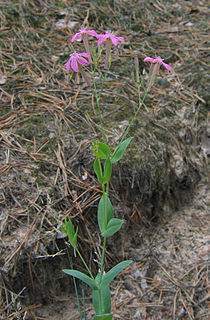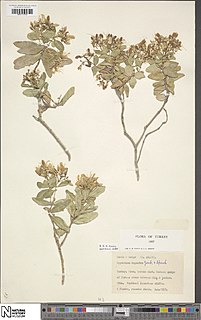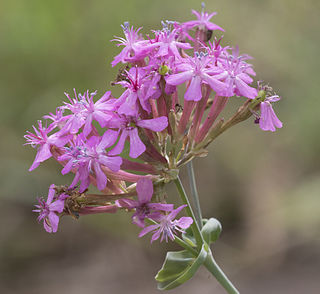
Cup and ring marks or cup marks are a form of prehistoric art found in the Atlantic seaboard of Europe (Ireland, Wales, Northern England, Scotland, France, Portugal, and Spain – and in Mediterranean Europe – Italy, Azerbaijan and Greece, as well as in Scandinavia and in Switzerland.

Silene armeria, commonly known as the Sweet William catchfly, is a species of plant in the family Caryophyllaceae. Originally a native of Europe, it has become widespread in the United States. Perennial in USDA plant hardiness zones 5 to 8. A small-growing form is known as dwarf catchfly. The name comes from the way in which small insects are trapped by the sticky sap exuded onto the stem. However it is not currently regarded as a carnivorous plant, though it has been identified as a carnivorous plant in the past.
Toquepala Caves are located near Toquepala mine, about 154 km (96 mi) from the city of Tacna, in the extreme southeast of Peru. They are notable for a number of rock paintings. The best known of them is the cave named Abrigo del Diablo.

The campo rupestre is a discontinuous montane subtropical ecoregion occurring across three different biomes in Brazil: Cerrado, Atlantic Forest and Caatinga. Originally, campo rupestre was used to characterize the montane vegetation of the Espinhaço Range, but recently this term has been broadly applied by the scientific community to define high altitudinal fire-prone areas dominated by grasslands and rocky outcrops.

Zipacón is a municipality and town of Colombia in the Western Savanna Province, part of the department of Cundinamarca. The urban centre of Zipacón is situated at an altitude of 2,550 metres (8,370 ft) on the Bogotá savanna, the southern flatlands of the Altiplano Cundiboyacense in the Eastern Ranges of the Colombian Andes. Zipacón borders Anolaima, Facatativá, La Mesa and Bojacá.

The Prehistoric Rock-Art Site of Escoural Cave is a structure known for its Paleolithic-era rock-art and funerary burial site, located in the Portuguese municipality of Montemor-o-Novo, in the civil parish of Santiago do Escoural.

Piedras del Tunjo is an important archaeological park established on a natural rock shelter 40 kilometres (25 mi) west of Bogotá in the municipality of Facatativá.

Vals is a commune in the Ariège department in southwestern France.

The Roca dels Moros or Caves of El Cogul is a rock shelter containing paintings of prehistoric Levantine rock art and Iberian schematic art. The site is in El Cogul, in the autonomous community of Catalonia, Spain. Since 1998 the paintings have been protected as part of the Rock art of the Iberian Mediterranean Basin, a UNESCO World Heritage Site. Inscriptions in Northeastern Iberian script and in Latin alphabet indicate that the place was used as a sanctuary into Iberian and Roman times.
Ayamachay is an archaeological site with rock paintings in Peru. It is situated in the Cusco Region, Canchis Province, Combapata District, above the left bank of the Salqa or Salcca river near the village of Oroscocha or Oroscocha. The paintings are predominantly white and show abstract or geometrical figures.
Khichuqaqa is an archaeological site in Peru with rock paintings and tombs nearby. It is situated in the Cusco Region, Urubamba Province, Urubamba District. The site lies at a height of about 3,160 metres (10,367 ft) on the slope of the mountain Kapuliyuq.
Inkapintay or Inkapintayuq is an archaeological site in Peru with a rock painting. It is situated in the Cusco Region, Urubamba Province, Ollantaytambo District, near Ollantaytambo. The figure which draws the attention possibly depicts a noble person.
Qaqapatan (Quechua) is an archaeological site with rock paintings in Peru. It lies in the Pasco Region, Pasco Province, Yarusyacán District, at a height of 3,787 metres (12,425 ft). Qaqapatan is situated at a height of 3,782 metres (12,408 ft) at the foot of the mountain Qayakuna in the village Quchaq (Cochac), north of the town Cerro de Pasco.
Wila Wilani is an archaeological site with rock art in Peru. It is located in the Tacna Region, Tacna Province, Palca District, near Wila Wilani (Vilavilane, Vilavilani). The motives of the paintings are predominantly hunting scenes with camelids.
The Prehistoric Rock-Art Site Pala Pinta is a Paleolithic-era rock-art site, recognized for cave paintings in the Portuguese municipality of Alijó, in the civil parish of Carlão e Amieiro.
Quillarumi is an archaeological site with rock paintings located west of the town of Huánuco, Peru. It lies on a slope of the mountain at an elevation of 2,463 metres (8,081 ft).

The Cave of Maltravieso in Cáceres, Extremadura, Spain, was discovered in 1951. It shows traces of human occupation from the Middle Paleolithic. It contains cave art, most notably a total of 71 hand stencils, enumerated in the 1990s using ultraviolet photography, but also linear designs and some animal paintings. In a 2018 study based on uranium-thorium dating, a hand stencil from the Cave of Maltravieso was dated to 64,000 years ago. This would make it Middle Paleolithic art, predating the presence of European early modern humans, with important implications for Neanderthal behavior.

Arthrophyllum is one of 36 sections in the genus Hypericum. It contains 5 species and its type species is H. rupestre.

Hypericum rupestre is a species of flowering plant in the genus Hypericum. It is the type species of sect. Arthrophyllum. It was first described by Hippolyte Jaubert and Édouard Spach in 1842 in the journal Ill. Pl. Orient.. The species is found only in a small area in the southern region of Turkey.

Atocion is a genus of flowering plants in the family Caryophyllaceae, tribe Sileneae, native to Europe, the Caucasus region, and the Middle East as far east as Iran. The species diversity is highest in the Balkans.











